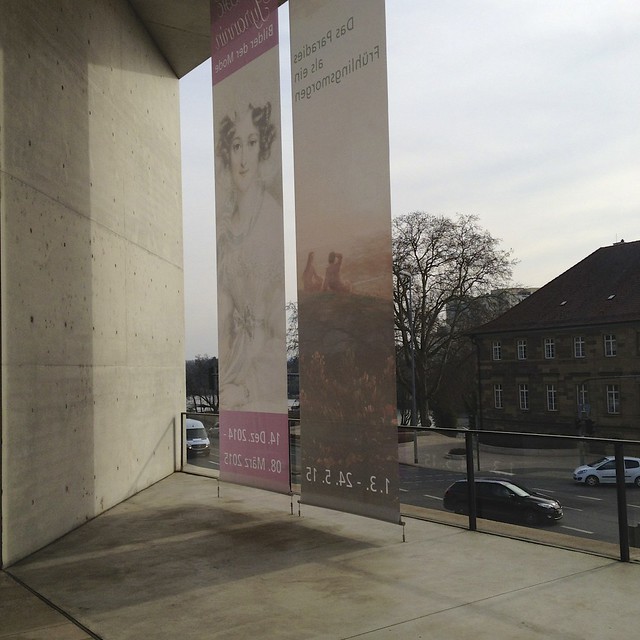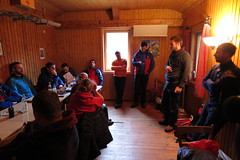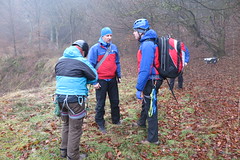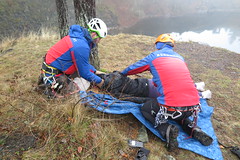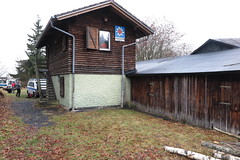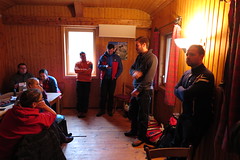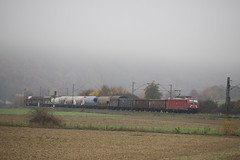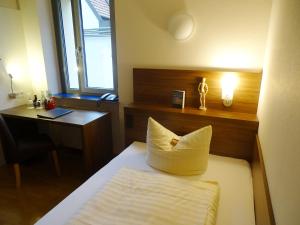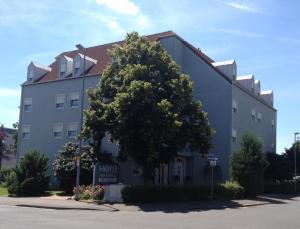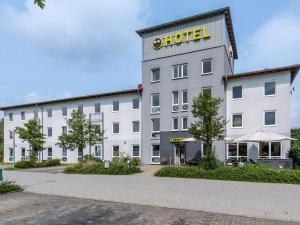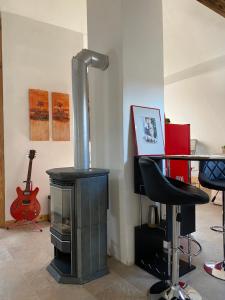Schweinfurt
Schweinfurt (English: /ˈʃvnft/ , German: [ˈʃvaɪnfʊɐ̯t];) is a city in the district of Lower Franconia in Bavaria, Germany. It is the administrative centre of the surrounding district (''Landkreis'') of Schweinfurt and a major industrial, cultural and educational hub. The urban agglomeration has 100,200 (2018) and the city's catchment area, including the Main-Rhön region and parts of South Thuringia, 759,000 inhabitants.
Schweinfurt was first documented in 791 and is one of the oldest cities in Bavaria. Around 1000 the Margraves of Schweinfurt controlled large parts of northern Bavaria. From the 12th century until 1802 Schweinfurt was a Free imperial city within the Holy Roman Empire, around 1700 a humanistic centre and in 1770 began the 250-year industrial history.
During World War II, the Americans suffered their biggest air defeat over Schweinfurt in the Second Raid on Schweinfurt (Black Thursday). On 11 April 1945, the US Army invaded the city. During the Cold War, the 1945 founded USAG Schweinfurt had the highest concentration of US combat units in the Federal Republic of Germany. In the northwest of Schweinfurt, an American town emerged, with a complete civil infrastructure including all kinds of shops for 12,000 Americans, soldiers and civilians. Until the withdrawal of the US Army at Schweinfurt in 2014, a total of about 100,000 US soldiers were stationed in the town.
Following German Reunification in 1990, Schweinfurt has become an important traffic hub in the centre of Germany. It has the highest employment density (2015) and the third highest gross domestic product per inhabitant of Germany (2014). The world's largest bearing group SKF, the second largest Schaeffler, the second largest automotive supplier in the world ZF Friedrichshafen and the DAX group Fresenius Medical Care have their largest plants in Schweinfurt.
Some important inventions have their origin in Schweinfurt: the pedal bike by Philipp Moritz Fischer (1853) as well as the freewheel (1889) and the coaster brake (1903) by Ernst Sachs. In 1652, the oldest permanently existing natural-scientific academy in the world was founded in Schweinfurt, the German National Academy of Sciences Leopoldina.
History
Pre-BCE History
Traces of settlement as early as 7500 years ago can be detected on today's urban area at various places. The first settlement of the historic Schweinfurt (Village Old Town) was also on the Main, between the two streams Höllenbach and Marienbach, 1 km east of the later founded imperial city, which corresponds to the old town today. The Village Old Town is in its origins at least 2100 years old.
8th–13th centuries
The first documentary mention Schweinfurts (village old town) took place in the year 791. Schweinfurt gained importance in 941 with the mention of Count Berthold as the first member of the House of the Counts of Schweinfurt. He occupied an important position in the central Reich territory, the Duchy of Franconia. Berthold gave the king of East Francia Otto I. (936–973), who in 962 became Roman-German Emperor, valuable weapons aid against rebellious tribal dukes. As thanks Berthold of Otto I received the counties for the Folkfeld- and the Radenzgau and the Margraviate for the Nordgau, about the present-day Upper Palatinate. Thus he was and from 980 his son Henry the most powerful secular nobility in the area of today's northern Bavaria.
Later supported Count Henry of Schweinfurt (called: Hezilo) the East Frankish Henry II (1002–1024, from 1014 Roman-German Emperor) in the royal election of 1002 and was awarded the Duke dignity of Bavarians. After the election, however, Henry II did not fulfill the promise. Thereupon it came to the Schweinfurt Feud in 1003. Count Heinrich lost all his possessions. The confiscated royal goods formed the core of the new bishopric of Bamberg. Hezilo, however, retained his possessions around the castle hill Peterstirn. The family, in which Judith of Schweinfurt became a central figure in the history of the old Schweinfurt city, died in the male line of 1057 and at the latest this year marks the undisputed end of the important role of the Margraves of Schweinfurt.
To the beginnings of today's old town from the 12th century, 1 km west of the previous settlement between the two streams Marienbach and Höllenbach, there are different views. The from a gradual construction to a planned Civitas Imperii (imperial city), so a founding city, by Emperor Frederick I Barbarossa, using existing royal estate, rich. In the struggle for supremacy in Main Franconia (region around the river Main) between the Henneberger and the Bishop of Würzburg, the city was destroyed between 1240 and 1250 (First City Spoilage). However, it is controversial whether this destruction was still in the old settlement between Höllenbach and Marienbach and thus a reason for the rebuilding of the city on the farther west, today's site was or whether the destruction took place here already. In a letter from King William of Holland dated January 9, 1254, it is said that Schweinfurt used to be imperial city (Swinforde, que olim imperii civitas fuerat). It remains unclear whether rights have ever been withdrawn from the city or whether only reference is made to the city's destruction. However, this letter is the first documentary evidence of Schweinfurt as imperial city and thus as a place with city rights.
13th–15th centuries
The (inner) city fortification of the new city was built and first documented in 1258, it is still largely preserved on Marienbach today. A document from 1282 signed by Rudolf I of Habsburg states that Schweinfurt was a free city within the Holy Roman Empire. By pledge 1309 Schweinfurt came to the House of Henneberg, who maintained from 1310 to 1427 a Reichsburg (castle of the empire) in the old Schweinfurt city district Zürch.
In the 15th century began the construction of a territory around the core city, which lasted until 1620. In 1436, the fishermen's settlement of Fischerrain, which borders on the city wall and lies just to the southwest, whose origins lie in the darkness of history, was incorporated into the city. Due to positive economic development, the city can acquire the suburb of Oberndorf in 1436. 1436/37 received the advice of the city from the Teutonic Knights for 18,000 guilders the castle on the Peterstirn and the associated land area with the villages Zell and Weipoltshausen, which belongs to Üchtelhausen today.
16th–18th centuries
Schweinfurt joined the Reformation relatively late, in 1542 since the city, together with neighboring imperial villages and imperial villages, was completely surrounded by the Catholic Hochstift Würzburg. In a confession change had to be expected military assault. The patron of the city, Count Wilhelm von Henneberg, did not offer sufficient support.
In the course of the Second Margrave War, the city was looted in 1554 and set on fire. This went as the Second City Spoilage in the city history (First City Spoilage see: 8th–13th centuries). The reconstruction dragged on until 1615. In this form, the old town, with the exception of later modernized fortifications, remained almost unchanged until the early 19th century. In 1609 the city joined the Protestant Union. The imperial city territory was supplemented 1620 also still around Madenhausen, which also belongs to Üchtelhausen today. Due to the acquisitions, the territory of the imperial city now had an extension of 17 km from southwest to northeast. As a result of the city of Schweinfurt on the knight canton of Baunach a nearly continuous Protestant corridor was created by the Hochstifte Würzburg and Bamberg in the Protestant Duchy of Saxony.
Schweinfurt joined the Protestant Union in 1609. In the Thirty Years' War it was occupied by Gustavus Adolphus, who erected fortifications, the remains of which are still extant. In 1652 the four doctors Johann Laurentius Bausch, Johann Michael Fehr, Georg Balthasar Wolfahrt and Balthasar Metzger founded the Academia Curiosorum in Schweinfurt, which is known today as the German Academy of Life Scientists, "Leopoldina".
Schweinfurt remained a free imperial city until 1802, when it passed to the Electorate of Bavaria. Assigned to the grand duke of Würzburg in 1810, it was granted to the Kingdom of Bavaria four years later. The first railway junction was opened in 1852. In the following years Schweinfurt became a world leading centre for the production of ball bearings. This was to lead to grievous consequences for the city during World War II.
18th–20th centuries
The year 1770 marked the beginning of the industrialization of the city, with its 250-year-old industrial history. In the first century of industrialization, the chemical and paint industry started in Schweinfurt, with the construction of the Wolf's lead white mill at the Bleiweißmühlenwehr. According to Dr. Ferdinand Gademann (1880–1969), it was the oldest German lead white factory. In 1780 the factory was taken over by Johann Martin Schmidt. Further factory-similar plants of this kind originated at the Bellevue and in the neighboring suburb Niederwerrn.
Following the Reichsdeputationshauptschluss, Schweinfurt came to Bavaria in 1803, two years before the Kingdom of Bavaria was founded. 4000 people demonstrated against the Anschluss at the Rossmarkt. After the interim membership of the Grand Duchy of Würzburg (1810–1814), Schweinfurt fell in 1814 to the Kingdom of Bavaria. The villages belonging to the imperial city territory were spun off. As a result, Schweinfurt lost about two-thirds of its territory.
1852 took place with the opening of the Ludwigs-Westbahn from Bamberg to the new Schweinfurt Stadt station the connection to the railway network. With …
Hotels Schweinfurt
Looking for places related to Schweinfurt?
Those are other destinations to find places related to Schweinfurt:
